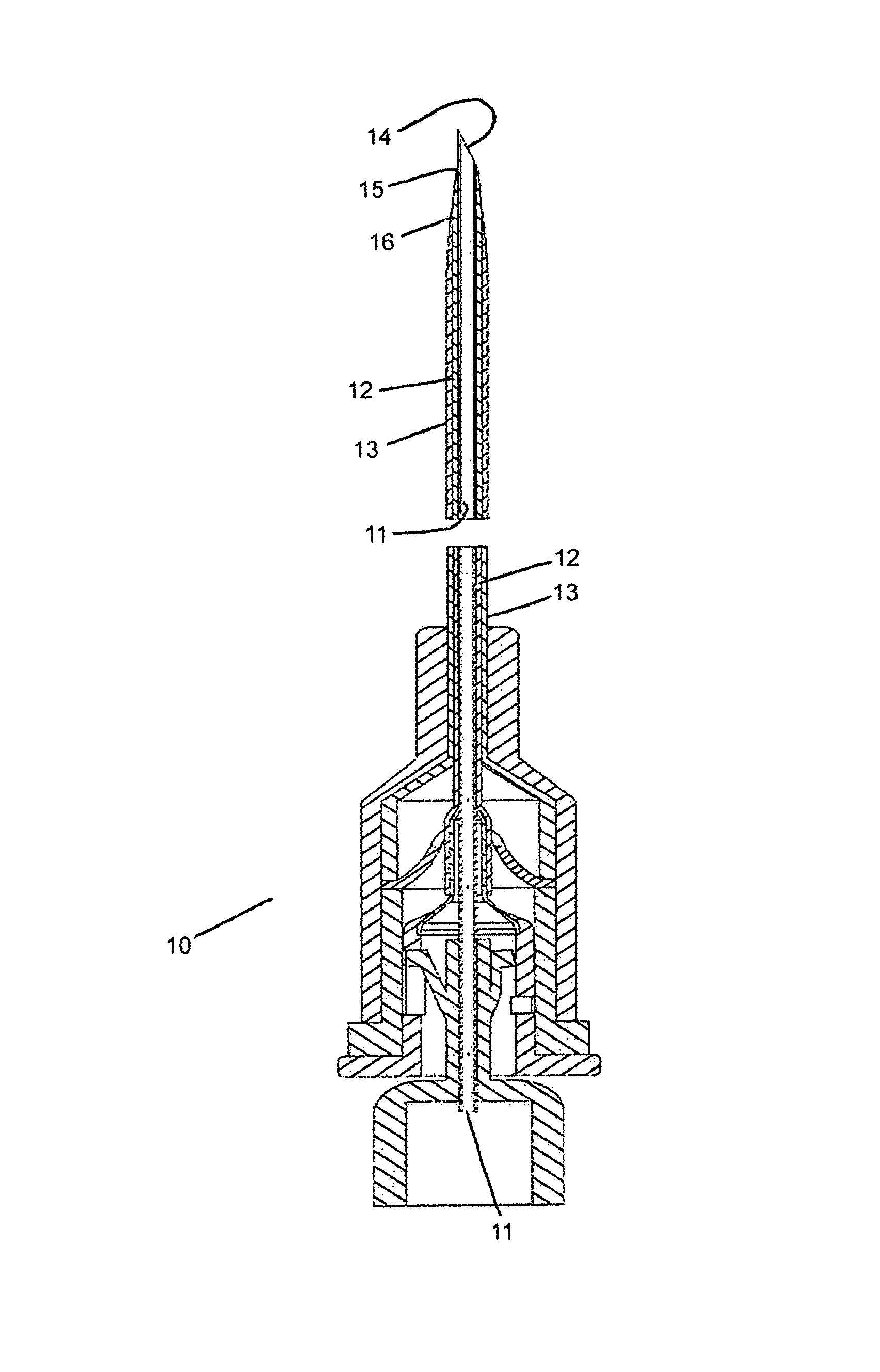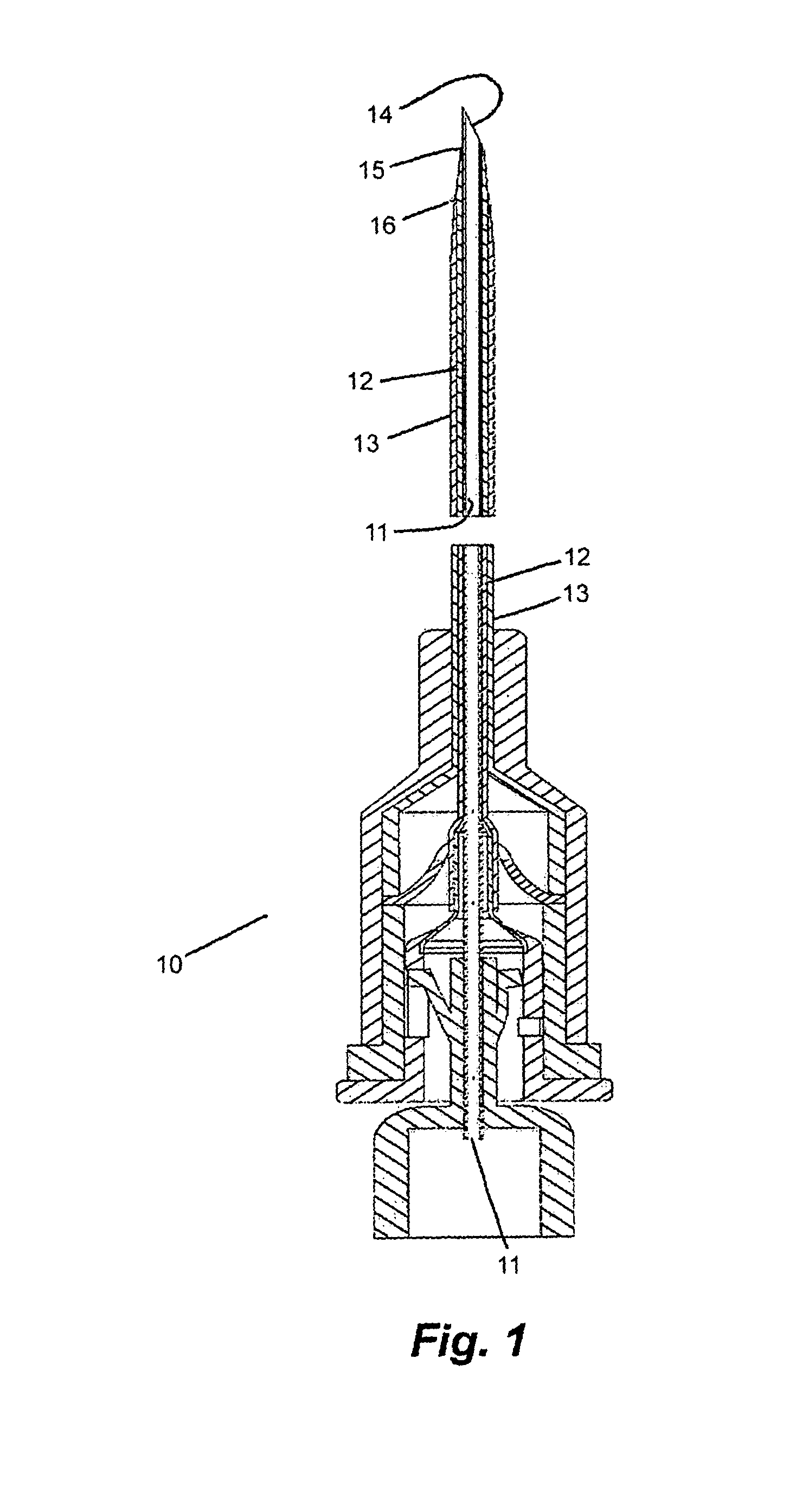Apparatus for peripheral vascular access
a peripheral vascular and appendix technology, applied in the direction of dilators, catheters, other medical devices, etc., can solve the problems of hematoma formation in surrounding tissue, associated pain and discomfort of patients, and still required significant skill for correct needle insertion
- Summary
- Abstract
- Description
- Claims
- Application Information
AI Technical Summary
Benefits of technology
Problems solved by technology
Method used
Image
Examples
example 1
[0101]An exemplary catheter insertion assembly can be manufactured including a guide needle for perforation of skin and vessel; a guide dilator to expand the needle perforation, protect the vessel from further perforations and to guide a catheter into the vessel; and, a catheter to provide access to the vessel by clinical technicians.
[0102]FIG. 1 shows a catheter insertion assembly 10 composed of a guide needle 11, typically formed from stainless steel; a guide dilator 12, typically a tough, flexible plastic such as polyurethane or polytetrafluoroethylene; and, an intra-vascular catheter 13, also produced from a tough, flexible material, and of a geometry needed for a given medical procedure. These three components of the invention are fitted together concentrically such that the distal end 14 of the guide needle protrudes from the distal end 15 of the guide dilator, and the guide dilator protrudes from the distal end 16 of the intra-vascular catheter.
[0...
example 2
Needle Retraction Limiter
[0106]In FIG. 5, the guide needle hub, the guide dilator hub, the one way valve, and the catheter hub are shown in their typical relative positions at the time the distal end of the guide needle and catheter are manipulated to penetrate the skin and vessel wall as described in FIG. 4. The guide needle hub 23 contains two molded tangs, one 61 of which fits into a slot 62 in wall of the guide dilator hub. The slot limits the travel of the tang, and therefore limits the travel of the guide needle relative to the guide dilator. The open length of the slot, “c”, is greater than the distance that the distal end of the guide needle protrudes from the distal end of the catheter guide; length “d” in FIG. 2. The second tang 63, attached to the guide needle hub, is squeezed against the inner wall of the guide dilator hub, such that the arm 64 of the tang is under tension in a bent mode. The elastic nature of the plastic used to produce the guide needle hub causes the t...
example 3
Withdrawal of Guides from the Assembly
[0109]Once the intra-vascular catheter is in position, the catheter body is held and further outward axial pressure on the guide needle allows the guide needle and guide dilator to be withdrawn from the catheter body / intra-vascular catheter / catheter body plug assembly. FIG. 8 shows the intra-vascular catheter 13 has been positioned fully in the targeted vessel 52 and the guide dilator and guide needle completely withdrawn.
[0110]FIG. 9 shows the corresponding view of the catheter body, the intra-vascular catheter, the catheter body plug, and the one way valve with its opening completely closed.
[0111]FIG. 10 shows an oblique view of the one way valve 17. The valve is composed of an outer flange 101, where it is held in position by the proximal end of the intra-vascular catheter and the catheter body plug; a generally conical shaped body 102 to make mechanical penetration easy in one direction and more difficult in the other; a rounded apex 103 in ...
PUM
 Login to View More
Login to View More Abstract
Description
Claims
Application Information
 Login to View More
Login to View More - R&D
- Intellectual Property
- Life Sciences
- Materials
- Tech Scout
- Unparalleled Data Quality
- Higher Quality Content
- 60% Fewer Hallucinations
Browse by: Latest US Patents, China's latest patents, Technical Efficacy Thesaurus, Application Domain, Technology Topic, Popular Technical Reports.
© 2025 PatSnap. All rights reserved.Legal|Privacy policy|Modern Slavery Act Transparency Statement|Sitemap|About US| Contact US: help@patsnap.com



